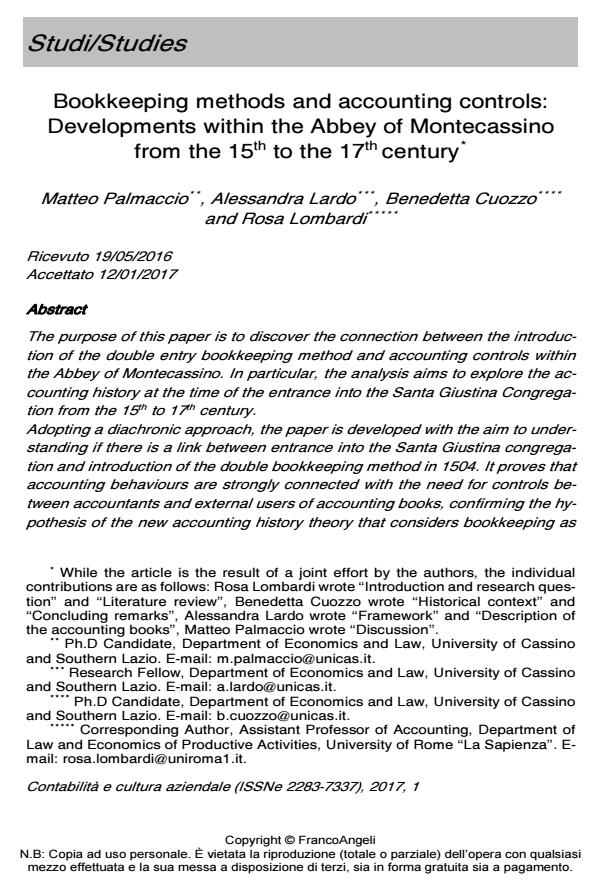Bookkeeping methods and accounting controls: Developments within the Abbey of Montecassino from the 15th to the 17th century
Titolo Rivista CONTABILITÀ E CULTURA AZIENDALE
Autori/Curatori Matteo Palmaccio, Alessandra Lardo, Benedetta Cuozzo, Rosa Lombardi
Anno di pubblicazione 2017 Fascicolo 2017/1
Lingua Inglese Numero pagine 21 P. 7-27 Dimensione file 199 KB
DOI 10.3280/CCA2017-001002
Il DOI è il codice a barre della proprietà intellettuale: per saperne di più
clicca qui
Qui sotto puoi vedere in anteprima la prima pagina di questo articolo.
Se questo articolo ti interessa, lo puoi acquistare (e scaricare in formato pdf) seguendo le facili indicazioni per acquistare il download credit. Acquista Download Credits per scaricare questo Articolo in formato PDF

FrancoAngeli è membro della Publishers International Linking Association, Inc (PILA)associazione indipendente e non profit per facilitare (attraverso i servizi tecnologici implementati da CrossRef.org) l’accesso degli studiosi ai contenuti digitali nelle pubblicazioni professionali e scientifiche
The purpose of this paper is to discover the connection between the introduction of the double entry bookkeeping method and accounting controls within the Abbey of Montecassino. In particular, the analysis aims to explore the accounting history at the time of the entrance into the Santa Giustina Congregation from the 15th to 17th century. Adopting a diachronic approach, the paper is developed with the aim to understanding if there is a link between entrance into the Santa Giustina congregation and introduction of the double bookkeeping method in 1504. It proves that accounting behaviours are strongly connected with the need for controls between accountants and external users of accounting books, confirming the hypothesis of the new accounting history theory that considers bookkeeping as social construction. The methodology is based on a comparison between two different methods of recording in the Abbey of Montecassino: the first refers to the period from 1450 to 1504 (Commendatory era) while the second considers the period after entrance into the Santa Giustina Congregation in 1504.
Parole chiave:Monastery accounting history, bookkeeping methods, accounting controls, New Accounting History, Abbey of Montecassino, Santa Giustina Congregation.
- Time, space and accounting at Nonantola Abbey (1350–1449) Michele Bigoni, Laura Maran, Silvia Ferramosca, in The British Accounting Review 100882/2021 pp.100882
DOI: 10.1016/j.bar.2020.100882 - La Verna Convent's accounting and non-accounting systems: Identifying the convent's stakeholders, their mutual relations, and their engagement in value creation Ilaria Elisa Vannini, Barbara Sibilio, in CONTABILITÀ E CULTURA AZIENDALE 2/2024 pp.59
DOI: 10.3280/CCA2024-002004 - The role of equity valuation in corporate crisis: The EFIM case Marco Lacchini, Matteo Palmaccio, Florinda Petrecca, Salvatore Vallefuoco, in CONTABILITÀ E CULTURA AZIENDALE 2/2024 pp.9
DOI: 10.3280/CCA2024-002002
Matteo Palmaccio, Alessandra Lardo, Benedetta Cuozzo, Rosa Lombardi, Bookkeeping methods and accounting controls: Developments within the Abbey of Montecassino from the 15th to the 17th century in "CONTABILITÀ E CULTURA AZIENDALE" 1/2017, pp 7-27, DOI: 10.3280/CCA2017-001002